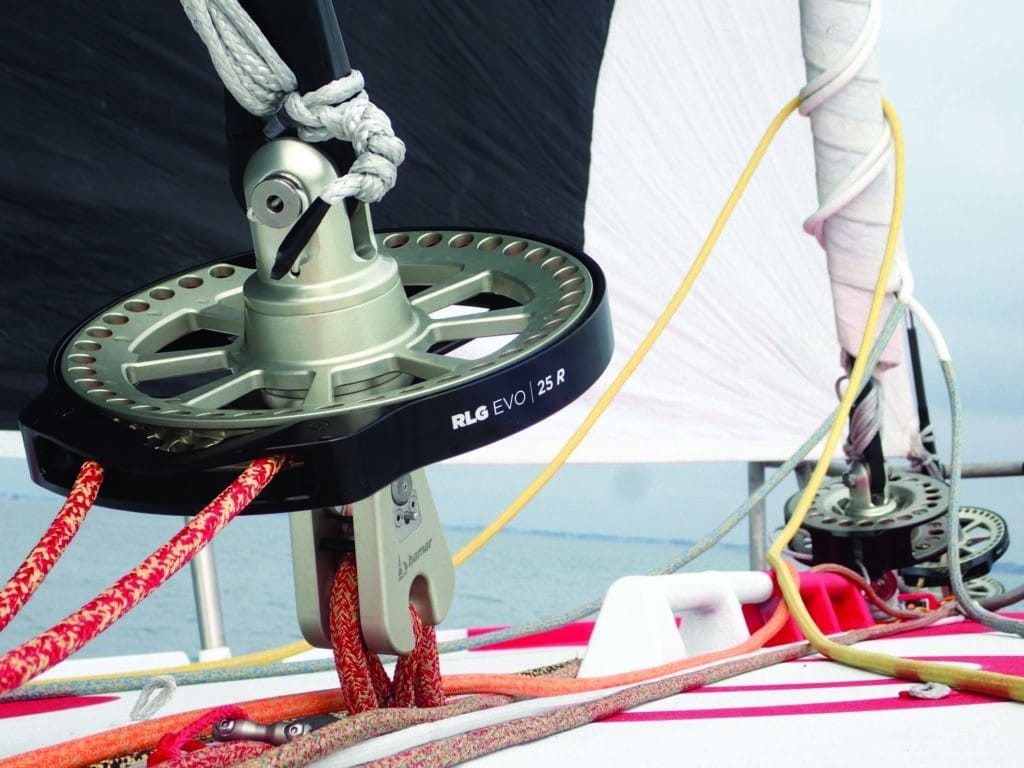
For many years the spinnaker sock has been the primary choice for shorthanded cruising sailors who fly big, colorful downwind sails. The sock is a simple device comprised of a funnel, a retrieval line and a nylon sleeve. To set a kite, you simply raise the funnel to the head of the sail, trim the spinnaker, and begin an enjoyable off-wind cruise.
Yet spinnaker socks can be hit-or-miss affairs. On some boats they work beautifully. On others they’ve been known to create macramé at the masthead or, in worst-case scenarios, slice the sail. But there’s one piece of equipment that can eliminate the sock and potentially make sailhandling much safer. Top-down roller furlers have become de rigueur for the superyacht crowd and offshore racing sailors. These furlers are so named because they furl a sail from the head down rather than the tack up.
How They Work
Rolling from the top down is a better action for today’s asymmetric off-wind sails, such as gennakers or screachers (see “Take It From the Top,” page 77). These sails typically have a luff length that is slightly longer than the leech length, a midgirth that is greater than the foot length, and a high clew point. Because of the free-flying luff and the ability to tuck away any additional sail material in the midgirth section, the sail is furled from the top down.
Top-down furlers can be easier and safer to use than a sock. Because the sail is rolled and not as exposed to the wind, top-down furlers may be hoisted and secured in place at the dock or mooring. A sock must be hoisted when desired and immediately stowed belowdecks upon retrieval. With a top-down furler, the sail may be rolled up if the wind pipes up, but it doesn’t have to be lowered until you’re safely moored. Rather than standing on a potentially pitching, heaving, rolling foredeck with your arms above your head, wrestling with a sock’s retrieval line, you can operate the roller furler from the safety of the cockpit, using winches and clutches. But rolling the sail can be tricky, and if not performed correctly, it is usually where the operation goes wrong.
A sock works well because it envelops the entire sail, leaving nothing exposed to a strong gust that could inhibit a clean douse. With a top-down furler, the boat should be at a certain angle of sail, with an apparent-wind angle between 120 and 160 degrees (depending on wind strength and sail area) and with a constant amount of tension on the sheet to roll the sail properly. If any of the leech is left exposed, a strong gust could catch it and make it more difficult to stow the sail in its bag and unfurl it the next time. Or if the sheet pulls down on the clew excessively and stretches the leech, the sail won’t roll properly. In another scenario, you might encounter the reverse roll effect, wherein the foot of the sail is wrapped up as the sail is being unfurled, causing a cluster of immense proportions.
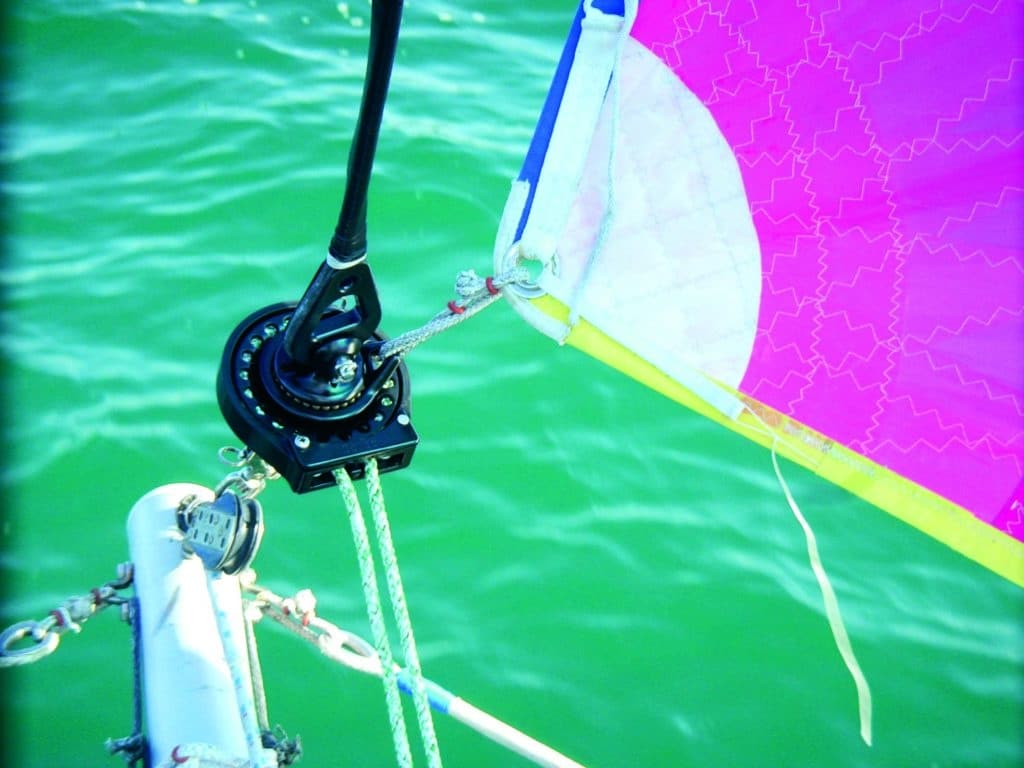
The key component of a good top-down furling system is the headstay cable, also called an anti-torque rope or tension cable. Regardless of the name, the stronger the cable, the better it is. With top-down furlers, the tack is mounted on a ring that encircles the anti-torsion cable just above the furling drum, which allows the head to begin furling before the tack. A taut cable will ensure torque is transferred evenly for the length of the cable, and that it remains in-line throughout the furling maneuver, which also aids a proper furl. You don’t want the cable to start bowing during the furling process, as it will lead to a bad furl and difficulties the next time you want to deploy the sail. The anti-torsion cable is what sets a top-down furling system at a high price point.
“For good spinnaker furling, a line that transmits torque very well is essential,” says John Franta, of Colligo Marine, which has made top-down furlers for asymmetric sails for three years. “You will have issues furling and unfurling your asymmetric sail with a twisty line. We recommend two hours to a couple of weeks to learn how to use the top-down system, because each system reacts differently based on the cut of the sail.”
Among the best anti-torsion cables on the market is the DynIce furling cable, sold with the Colligo, Profurl and Seldén systems. Manufactured by Hampidjan of Iceland, the cable has a core of DynIce Dux, a heat-set material with exceptional breaking loads and minimal constructional elongation. It has a double-braided cover of Dyneema SK75. A final polyester cover ensures the sail doesn’t stick to the cable. Other anti-torsion cable manufacturers include Future Fibres, Marlow, Harken and New England Ropes.
A basic top-down furler set will include the furling drum and a head swivel that attaches to the halyard. The drums and swivels are usually made of aluminum, titanium or stainless steel, and all have some sort of protective wrap to prevent the equipment from damaging the boat and mast. The furling drum must be tacked to a point that is forward of the headstay (which might mean adding some sort of bowsprit to some yachts). Most of the units come with quick-release pins to make removing the sail from the furling drum and head swivel easy.
Look for an adjustable tack line to set luff tension and for fine-tuning the sail shape. Tension the luff to make furling more efficient, and ease it when the sail is unfurled to induce more depth in the sail for better performance. Also pay attention to the covering on the anti-torsion cable. You don’t want the cable to damage the sail as it rolls.
There are many options in the marketplace for top-down furlers. We’ve chosen to highlight models from Bamar, Colligo, Harken, Profurl, Ronstan and Seldén, as they run the range from simple (Profurl) to robust (Bamar). It should be noted that these manufacturers market both bottom-up and top-down furler units. In most cases, a company’s top-down furler is developed from its bottom-up units. For the purpose of this story, we’ve focused on the top-down units only. Finally, we haven’t included the high-end custom units for which companies such as Karver and KZ Marine are renowned.
Ultimately, a spinnaker sock is the least expensive solution to spinnaker handling, costing around $1,500. Top-down furlers start at that price and can rise to $5,000 or $6,000 quickly, depending on the size of your boat, the sail, and the anti-torsion cable. Your choice will depend on your budget and your sailhandling requirements.
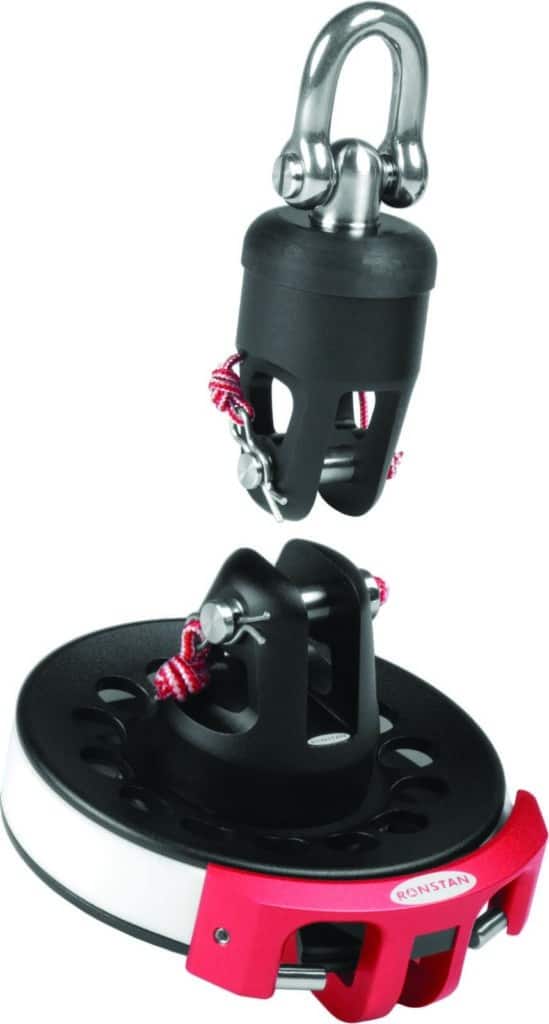
Bamar
An industry leader in the category, Bamar conceived of the top-down furler 12 years ago. In 2004, its motorized RollGen-Code furler won the overall DAME Design Award, which recognizes outstanding innovation for new products and accessories in the marine industry. The RollGen furler may be used with asymmetric spinnakers requiring a top-down furl and with code sails (like the code zero) that are furled traditionally, from the tack up. The system is driven either manually or by a hydraulic or electric motor that utilizes a special self-aligning spherical construction. It is designed to be flush-mounted on deck.
The RollGen furler can be used on boats ranging from 25-footers to superyachts, with sail areas from 1,100 square feet (safe working load of 4,400 pounds) to 4,600 square feet (safe working load of 33,000 pounds).
Bamar’s RLG Evo is an evolution of its RollGen system and ideal for code sails, staysails, gennakers and asymmetric spinnakers with a free-flying luff. Designed for any size boat, the RLG Evo is a low-profile unit constructed of Ergal aluminum, 17-4PH steel and carbon-fiber drum cages (for the larger sizes).
Bamar offers two types of anti-torsion cables. One is a Dacron-cored cable for use with its smaller furlers. Bamar’s top-of-the-line cable is its 3K Stay, constructed of Technora, a high-tech aramid synthetic fiber with high tensile strength and long-term dimensional stability. The core is covered with three layers of Technora, each wound more tightly than the previous. All of the stays have a high-strength foam-rubber gaiter over the cable to protect the sail from abrasion and wear during the furling process.
Bamar sells five models of its RLG Evo line, for boats ranging in size from 26 to 120 feet, or working loads from 4,400 to 33,000 pounds. The prices range from $2,425 for the RLG Evo 08-15M to $3,750 for the RLG Evo 10-17M and $6,750 for the RLG Evo 20. Adding the optional 3K stay increases the price to $5,175 for the RLG Evo 10 and $8,950 for the RLG Evo 20. (The 3K stay is not offered with the RLG Evo 08; it may be purchased separately.)
Colligo Marine
Colligo Marine offers three unique models designed with maintenance-free bearing systems that can all be taken apart and serviced if needed. The aluminum furling drum has a plastic Delrin guide around the drum to prevent it from damaging the boat. The CN3S and CN5S are robust designs for active cruising. They both have angular, double-row sealed bearings to handle both thrust and axial loads. The CN3S is recommended for sails up to 600 square feet and has a safe working load of 3,000 pounds. The CN5S is for sails up to 1,000 square feet and has a safe working load of 5,000 pounds.
The CN1.5S is a lighter-weight version of the CN3S, designed for smaller sail areas. It has the same 3,000-pound safe working load as the CN3S but comes with a ceramic bearing system and is designed for sails up to 500 square feet. “Sizing also depends on sail type and weight, predicted usage, and boat geometry,” says Colligo’s John Franta.
The Colligo CF1.5S is priced at $1,395, the CN3S at $1,525, and the CN5S at $2,500. Those prices are for the furling drum and head swivel only and do not include the continuous furling line for the drum or the anti-torsion cable, which will add anywhere from $300 to $800 to the final price tag. Colligo also manufactures furling-line terminators (“furlinators”) and special clamps for torque lines that can be removed to reset the length if it isn’t cut right the first time.
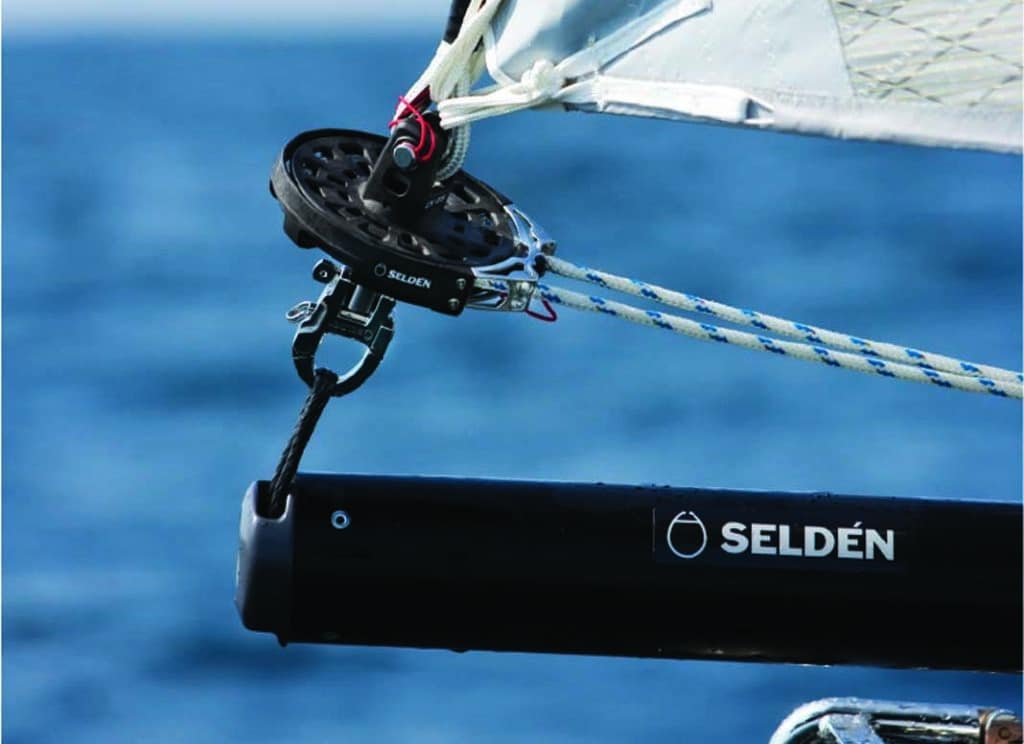
Harken
Harken recently joined the top-down fray with its new Harken Reflex furling system. “The key is in the cable,” says Jim Andersen, the company’s U.S. sales manager. To provide a torsion cable stiff enough to deliver torque to the top of the sail, where it’s needed to begin furling, the company developed its own brand of cable that consists of a braided polyester core covered with a stainless-steel mesh. The cable is then coated with Santoprene, a thermoplastic covering. Because of the cable’s stiffness, it doesn’t need to be cranked bone-tight, as some top-down furlers require, which means there’s less load on the halyard, sprit and tack fitting. Still, the cable is flexible enough that once furled, the sail can be lowered, coiled and stowed.
The Reflex system consists of the Reflex cable, a continuous-line furling drum, threaded snap-shackle and soft-shackle deck fittings that screw into the base of the furler, a head swivel, and either a tack swivel for asymmetric spinnakers or a fixed tack fitting for reaching sails that have a cable in the luff. The cable, tack and head fittings remain with the sail; the tack connects to the furler’s drive spool with a slide-on T-track that’s locked in place by a spring-loaded pin.
The furlers are sold in kits. Unit 1 furlers come with a 9-millimeter cable for boats from 25 to 36 feet with a 1.5-ton maximum working load; the maximum sail area is 1,200 square feet for spinnakers and 650 square feet for code zeros. Kits start at $1,884. Unit 2 furlers, with a 13-millimeter cable, are designed for boats up to 45 feet with a maximum working load of 2.5 tons; the maximum sail area is 1,800 square feet for spinnakers and 900 square feet for code zeros. These kits start at $2,252. Additional cable and head and tack fittings can be purchased separately for those with multiple downwind headsails. The Reflex cable can also be used with other top-down furlers. The cable is easily cut using snips or a hacksaw, and clamps are included to connect end fittings. Detailed instructions and online guides make the systems easy for the do-it-yourselfer to install.
Profurl
Profurl markets the Spinex line of furlers, which are developed from the company’s NEX line of furlers for straight luff sails such as code zeros. They’re designed to be purchased off the shelf at stores such as West Marine and installed by the owner without the assistance of a rigging specialist.
The Spinex furlers come with Profurl’s Sail Bearing technology, which consists of high-density spheres that spin freely around the anti-torsion cable to protect the sail from the cable. The company says the spheres also help prevent the reverse furl effect, wherein the foot of the spinnaker is sucked in while the leech is being unfurled.
“Sail Bearing technology allows you to keep the sail away from the cable, stop reverse furling that causes the sail to jam, reduce wear of the sailcloth, and make furling easier and faster because it has a greater diameter than the cable on its own,” says Profurl’s Vernon Hultzer.
The Spinex range includes four models, the Spinex .9, 1.5, 2.5 and 5.0, which are designed for boats from 16 to 60 feet with a maximum sail area of 2,690 square feet. The model number corresponds to the unit’s breaking strength in kilograms. For example, the Spinex .9 has a breaking strength of 900 kilograms (1,984 pounds), and the 5.0 has a breaking strength of 5,000 kilograms (11,023 pounds). The Spinex furler comes complete with drum, swivel, anti-torsion cable with spheres, end fittings, and tack swivel. Aside from cutting the cable to its necessary length, Spinex units are ready to be used out of the box. Prices are $2,449 for the Spinex .9, $2,999 for the 1.5, $3,949 for the 2.5, and $6,099 for the 5.0.
Ronstan
Ronstan offers seven different types of top-down furlers between its Generation 1 and Generation 2 lines. The Generation 2 furlers were introduced roughly two years ago, with a focus on reducing weight as well as keeping costs down by using off-the-shelf 2-to-1 attachments and snap shackles. The Generation 2 furlers are offered in Series 80, 120 and 160 models; the Generation 1 furlers are offered in Series 170R, 200, 200R and 280 units for larger and more powerful boats.
All of the Ronstan furlers (excluding the Series 60, designed for the Weta trimaran) feature all-aluminum construction on the drum and swivel. The only piece of plastic is the “gate” that holds the furling line captive in the drum.
Ronstan recommends its Generation 2 furlers for boats ranging in size from 30 to 46 feet, and its Generation 1 units for larger boats up to Mini Maxis, but the products are rated based on maximum working load. The MWL for the Series 80 is 2,090 pounds; for the series 120, it’s 3,970 pounds; and for the Series 160, it’s 6,610 pounds. Prices range from $1,395 for the Series 80 to $2,195 for the Series 120 and $4,295 for the Series 160. The prices include the furling drum with snap shackle and head swivel.
Ronstan distributes the FSE Robline GFL anti-torsion cable with its furlers at an additional cost. The cable has a 32-plait polyester cover that makes it resistant to abrasion and UV damage and prevents any core or cover slippage. The core is 12-plait Vectran fiber for the lowest stretch, and additional impregnation provides further protection against UV damage and abrasion.
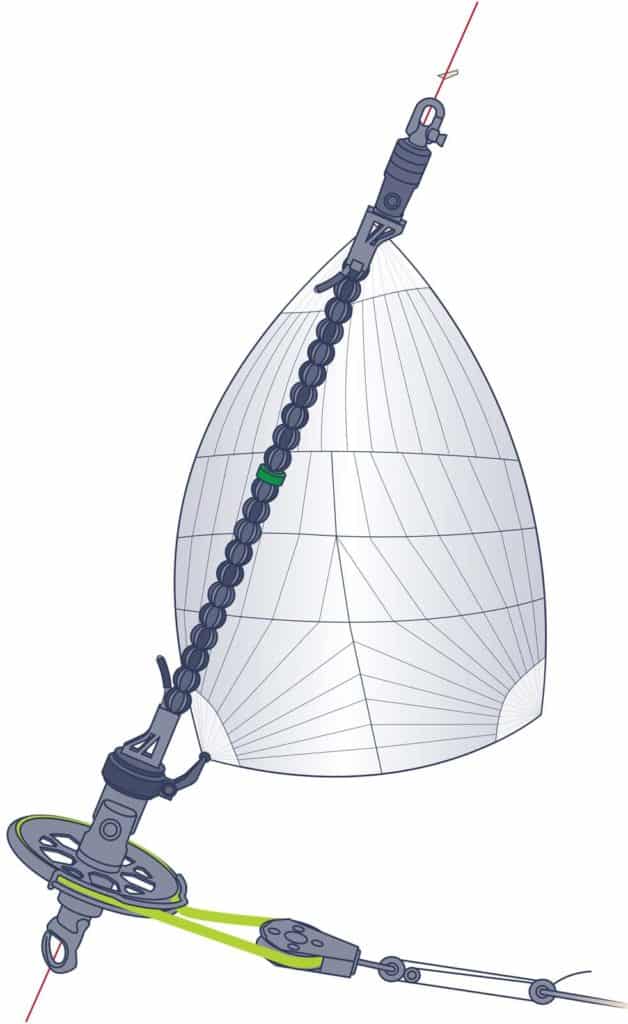
Seldén
Seldén’s primary top-down furler is the GX model, which is an evolution of the company’s CX model. The GX furler won the 2014 Editors’ Choice Award from Practical Sailor magazine and comes in a kit that includes a drum, halyard swivel and anti-torsion cable. The drum and halyard swivel are permanently fitted to the sail with Seldén line locks.
All of the GX’s structural parts are constructed of high-strength duplex stainless steel, which Seldén says has a 50 percent greater breaking strength than SAE 316 stainless steel. The halyard swivel has sealed steel bearings, and a rubber fender helps prevent abrasion to the mast.
Seldén manufactures four different sizes of the GX, all based on sail area. The GX 7.5 is recommended for a maximum sail area of 540 square feet, or a safe working load of 1,685 pounds; the GX 10 is rated for a sail area of 860 square feet, or a 2,250-pound safe working load; the GX 15 is for a sail area of 1,240 square feet, or a 3,375-pound safe working load; and the GX 25 is for boats with a sail area up to 2,155 square feet, or a 5,510-pound safe working load.
The suggested retail price for the four units ranges from $930 to $2,550.
Seldén also offers a double fairlead that consists of a composite bracket fitted to a 25-millimeter or 30-millimeter stanchion and a spring-loaded stainless-steel “push-and-twist” bracket. It’s easy to open to attach the furling line and just as easy to close.
Sean McNeill is a sailing writer based in Newport who’s covered pro sailing events such as the America’s Cup and Volvo Ocean Race for the past 25 years.








